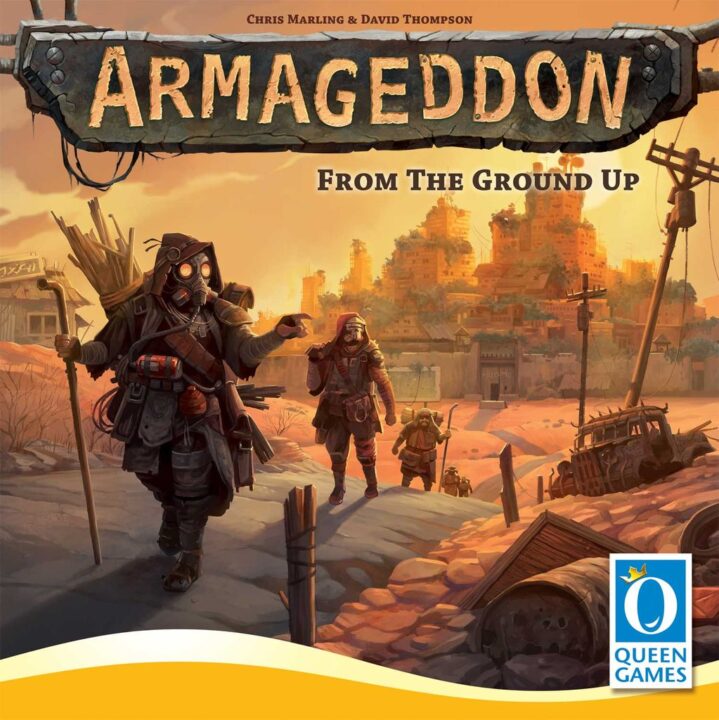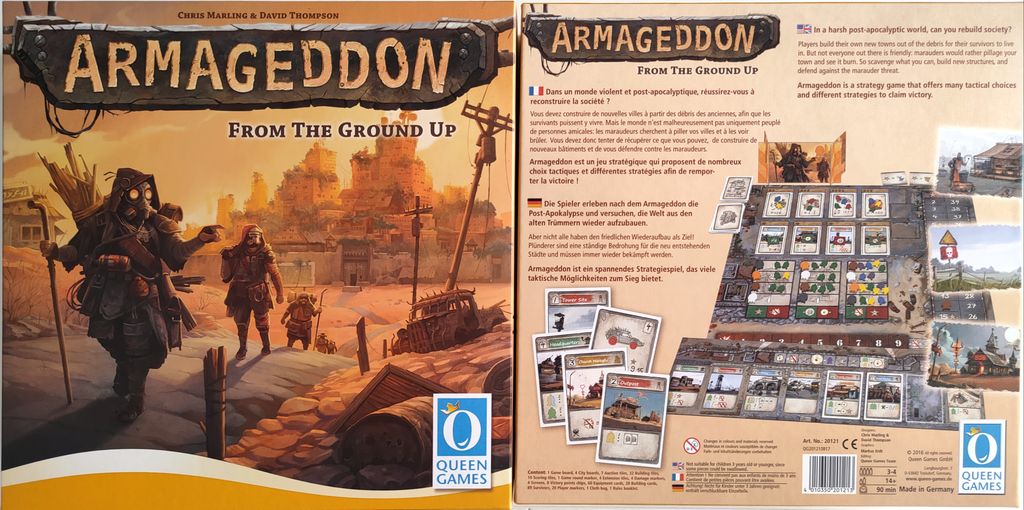Welcome to my review of Armageddon, where strategy meets the end of the world! I got my friends together for a few rounds of this post-apocalyptic survival game, and let’s just say, it was a wild ride. From balancing strategy and luck to engaging in intense player interaction, there’s a lot to unpack. But don’t worry, I’ll break it all down, including the good, the bad, and the downright dicey moments.
How It Plays
Setting up
To start, set up the modular board according to the chosen scenario. Place the resource tokens and survivor meeples in their designated spots. Each player gets a player board, starting crew, and some resources.
Gameplay
In Armageddon, players take turns performing actions like exploring, trading, building, and recruiting. The game has a clever bidding system for new survivors and buildings. Watch out for event cards that can throw a wrench in your plans!
Winning the game
The game ends after a set number of rounds or when certain conditions are met. Players tally up their points from buildings, survivors, and resources. The player with the most points wins, so plan wisely!
Want to know more? Read our extensive strategy guide for Armageddon.
Game Mechanics and Balance in Armageddon
When it comes to game mechanics and balance, Armageddon makes an interesting case. My friends and I had quite the apocalyptic showdown. The game’s core revolves around post-apocalyptic city-building and resource management. You’d think this would be straightforward, but oh no! The mechanics are as complex as grandma’s knitting.
One standout feature is the bidding system. Players bid for essential workers to rebuild their city. It’s a frenzy of strategy and second-guessing. But here’s the catch: if your bids fail, you could end up with less than you started with. My buddy, Dave, got stuck with a vibing chef and not much else. Talk about life lessons!
Balance-wise, Armageddon does a decent job. The mix of strategy and resource management keeps everyone on their toes. Unlike some games (*cough* Risk *cough*), there aren’t many unfair mechanics. But, occasionally, luck can creep in. A bad roll of the dice can turn your carefully laid plans into a dumpster fire. Just ask my friend Sarah, whose city crumbled faster than a cookie in milk.
Overall, Armageddon strikes a fair balance between strategy and chance. You won’t feel like the game is out to get you, unless dice hate you specifically—which is a real possibility, by the way.
Are we ready for the next bombshell? I’ll be talking about player interaction and engagement next. Stay tuned for the fun!

Player Interaction and Engagement in Armageddon
Playing Armageddon feels like navigating through a post-apocalyptic family reunion. You know, the one where Aunt Judy’s homemade salsa could literally destroy the dinner table? The game thrives on player interaction, and this isn’t just a polite way of saying, ‘You’ll be arguing a lot.’ No, I mean it in the best way possible! From trading resources to outright sabotaging each other, Armageddon makes sure players are engaged and constantly on their toes.
One time, my buddy Dave decided he wanted all the fancy equipment tiles for himself. So, he started hoarding resources. But the rest of us? We weren’t going to let that fly. We teamed up, traded up, and before Dave knew it, he was left with a bunch of scrap metal and a lot of regret. The way the game encourages alliances and then shatters them in seconds is both cruel and beautiful – like a Shakespearean drama, but with more zombies.
The bidding mechanics for resources and workers also keep things spicy. You think you’ve got that sweet new hammer in the bag, and then BAM! Linda bids one more resource than you. Seriously, Linda, why you gotta be like that? These interactions ensure not one player is ever left feeling like they’re floating in a wasteland of boredom.
However, there’s a slight downside. If one player becomes too powerful too quickly, others might feel like they’re just there to watch the chaos unfold. It’s a tricky balance, but for the most part, Armageddon nails it.
Next up, let’s chat about the Replay value and variability. Spoiler: Armageddon’s got some tricks up its sleeve here!

Replay Value and Variability in Armageddon
Armageddon offers a lot when it comes to replay value and variability. If you’re like me and always look for reasons to bring the same game back to the table, this one does not disappoint. One key factor lies in its modular board setup. No two games will ever look the same, and that keeps things fresh and exciting.
Each game in Armageddon feels like a new adventure due to random events and different starting conditions. Plus, the variety of survivor cards, equipment cards, and building tiles ensures that players will face unique challenges every time. My friends and I have experienced countless “do you remember that time when…” moments because of this. For instance, there was one game where I found myself leading a community of scientists armed with frying pans. Don’t ask me how that happened, but it was hilarious!
The endgame scenarios also add another layer of variability. There are multiple ways to end the game, from reaching a certain number of rounds to achieving specific objectives. This makes you approach each game with a different strategy, keeping you on your toes.
One downside, though, is that some players might find the variability overwhelming. If you’re someone who prefers a predictable experience, this might not be for you. However, for those of us who thrive on unpredictability, this is a gem.
All in all, Armageddon excels in keeping players coming back for more. Now, let’s see if the components and artwork win us over just as much as the gameplay does.
Component Quality and Artwork in Armageddon: Worth the Hype?
When it comes to board games, nothing quite kills the vibe like flimsy pieces and dull artwork. Let’s talk about the components and artwork in Armageddon. Spoiler alert: there’s both good and not-so-good to discuss.
First, the components. The game features sturdy, well-crafted pieces. The buildings and resources have a tactile feel that enhances the gaming experience. The cardboard tokens are thick enough to survive epic game nights, even when elbows get a bit too enthusiastic. The game board itself, modular and flexible, is particularly notable. You could probably use it as a shield in a real armageddon!
However, not everything is sunshine and rainbows. The dice, used frequently in this game, could have been better. They feel light and cheap, which is a bummer when you’re making crucial rolls. Rolling them feels more like shaking a maraca than determining the fate of your post-apocalyptic civilization.
Now onto the artwork. Armageddon nails the theme. The graphic design paints a vivid picture of a world gone to ruin. The characters have a gritty, detailed look that adds to the atmosphere. Each card and component reflects the desolate, survivalist vibe the game aims for.
But, while the artwork is thematic, it can also be a bit busy. The intricate details may seem overwhelming, especially for newbies. I lost count of how many times someone asked, “What does this do again?” on their first playthrough.
So, do I recommend Armageddon based on its component quality and artwork? Absolutely, but with a minor caveat. If you can overlook the dice and don’t mind a busy visual, you’ll find yourself in a richly detailed, immersive world.
Conclusion
To sum it up, Armageddon is a solid game if you enjoy strategy and can handle a bit of luck. The balance between these elements is decent, but dice rolls can still throw a wrench in your plans. The game thrives on player interaction with its trading, alliances, and bidding mechanics, although keeping the balance can be a challenge. With its modular board setup and diverse cards, Armageddon offers good replay value, though the variability might be too much for some. The component quality is generally sturdy, and the artwork fits the theme well, but the dice feel cheap, and the details can be overwhelming for beginners. All in all, Armageddon provides a mostly balanced and engaging experience, earning it a solid 4 stars out of 5 from me. This concludes the review.

